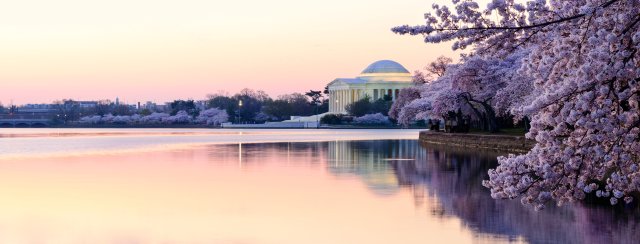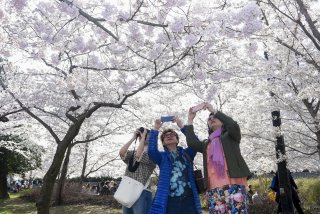Climate Change Connections: Washington, D.C. (Cherry Blossoms)
Climate change is impacting all regions and sectors of the United States. The State and Regional Climate Change Connections resource highlights climate change connections to culturally, ecologically, or economically important features of each state and territory. The content on this page provides an illustrative example. As climate change will affect each state and territory in diverse ways, this resource only describes a small portion of these risks. For more comprehensive information about regional climate impacts, please visit the Fifth National Climate Assessment and Climate Change Impacts by Sector.
On this page:
Introduction: Cherry Blossoms Have a Rich History and Vibrant Role in Washington, D.C.
With a history rooted in diplomacy, cherry trees are an iconic symbol of Washington, D.C. The flowering cherry tree, or Sakura, holds a special place in Japanese culture, and the tradition of celebrating the blooming of cherry trees has been observed there for centuries.1,2 Japan first offered 2,000 cherry trees to the United States in 1909 as a gift of friendship. However, when an insect infestation was discovered in them, the first group of trees had to be destroyed.1 In 1910, Japan offered a second gift of 3,020 trees from the banks of the Arakawa River—one of Japan’s most popular cherry blossom viewing spots.1 Many trees of the Yoshino variety included in this gift were planted around the Tidal Basin, where they and their descendants still live and blossom today.

Today, the cherry blossoms remain as important and celebrated in Washington, D.C., as they were over 100 years ago. The National Cherry Blossom Festival was inspired by a simple ceremony in March of 1912, in which First Lady Helen Herron Taft and Viscountess Chinda, wife of the Japanese ambassador, planted the first two Yoshino cherry trees along the Tidal Basin.1 Today, the National Cherry Blossom Festival attracts more than 1.5 million annual visitors to Washington, D.C.3,4 In addition to cherry blossom viewing, activities that visitors can enjoy include a parade, live music and performances, art installations, kite making and flying on the National Mall, a 10-mile run, Japanese cultural exhibits, and food and drink. Although the festival is free to attend, it offers an important economic boost to the city, as visitors spend money on food, lodging, shopping, and other experiences while in town. The festival also has a publicity value of over $300 million and generates more than 6 million social media impressions, attracting the participation of numerous advertisers and brands.4

The National Cherry Blossom Festival is planned to coincide with the peak bloom of the cherry trees. The “peak bloom” is defined as the day when 70 percent of the blossoms are in full bloom. The exact timing of peak bloom varies from year to year and is largely driven by local temperatures during the winter and early spring.3 Though April 4 is the average peak bloom date of cherry trees in Washington, D.C., the festival spans nearly an entire month, typically beginning around March 20 and ending in mid-April, to accommodate an earlier- or later-than-average peak bloom date.3
Climate Impacts: Warmer Temperatures Are Affecting the Timing of Blooms
Concentrations of heat-trapping greenhouse gases are increasing in the Earth’s atmosphere and, as a result, average temperatures at the Earth’s surface are increasing. Warmer temperatures can affect the timing of leaf and bloom dates. Though the dates of the National Cherry Blossom Festival aim to provide a wide cushion on either side of the average peak bloom date, the Tidal Basin’s Yoshino cherry trees have bloomed closer to the beginning of the festival in recent years. In some years, the festival has missed early peak bloom dates entirely.3
Since 1921, peak bloom dates have shifted earlier by about seven days, and the peak bloom date has occurred before April 4 in 16 of the past 20 years.3 Many plants are sensitive to temperature and use it as a cue to initiate various stages of their life cycle, including reproduction (blooming).3 Scientists have very high confidence that recent warming trends in global climate are causing spring events such as leaf growth and flower blooms to happen earlier.5
Earlier bloom dates could negatively affect tourism and the local economy in Washington, D.C.3 Peak bloom dates occurring weeks before the average can complicate festival planning. Unpredictable peak bloom dates could also make it challenging for visitors to plan travel and accommodations. Visitors trying to catch a glimpse of the beautiful blossoms may not be the only ones who could be thwarted by the increasingly unpredictable bloom dates. Warming temperatures can lead to cherry trees blooming at a time when pollinators, like bees and butterflies, are not yet mature and ready to pollinate.6 This timing mismatch can impair both the reproductive capacity of plants and the ability of pollinators to gather nectar.7
Tidal Basin Flooding Threatens Cherry Trees

The iconic Tidal Basin cherry blossoms are also vulnerable to sea level rise. Globally, warming temperatures are causing sea levels to rise. The two key ways warming temperatures affect sea level is through the addition of water from melting land ice (like glaciers and ice sheets) and the expansion of water due to warming ocean temperatures.8 The Mid-Atlantic is experiencing comparatively higher rates of relative sea level rise due to the combination of natural sinking of land and increases in absolute sea level rise.9 Rising sea levels can contribute to increased tidal flooding.10 High tide flooding, also known as nuisance or sunny day flooding, takes place when water levels reach above the average high tide mark for a certain location.11 The term “sunny day flooding” is used because severe weather is not required for these floods to occur.10
During high tide, about 250 million gallons of brackish water—a combination of salt and fresh water—flow from the Potomac River into the Tidal Basin, raising water levels.12 Washington, D.C., has experienced a significant increase in nuisance or tidal flooding events in recent decades.13 Flooding can cause the brackish water in the Tidal Basin to wash over the roots of the cherry trees. Cherry trees require fresh water, and salty soil can eventually weaken and kill them.
Taking Action: Planning for Warming Temperatures and Rising Tides
Addressing climate change requires reducing greenhouse gas emissions while preparing for and protecting against current and future climate impacts. Communities, public officials, and individuals in every part of the United States can continue to explore and implement climate adaptation and mitigation measures. In the nation’s capital, city officials and U.S. National Park Service (NPS) staff are taking steps to protect the iconic cherry blossoms, including:
- Resilient planning and infrastructure. The government of Washington, D.C., has already begun taking steps to prepare for climate change, including developing a climate change adaptation plan.14 The National Park system and city officials are collaborating with nonprofits on design improvements to the Tidal Basin’s infrastructure to make it more resilient to current and projected flooding.15
- Visitor education. The NPS has performed outreach to help educate visitors on how to protect the trees.16 Everyone can do their part by practicing “leave no trace” principles when visiting cherry blossoms at the Tidal Basin and across the city. Appreciating the blossoms without touching the trees and staying on sidewalks to avoid damaging tree roots help protect the trees for others to enjoy.
To learn more about climate change impacts in Washington, D.C., and the Southeast region, see Chapter 22 of the Fifth National Climate Assessment.
Related Resources
- EPA Climate Change Indicators: Community Connection: Cherry Blossom Bloom Dates in Washington, D.C.
- Maryland and the District of Columbia State Climate Summary 2022 (NOAA)
- Cherry Trees and Climate Change (NPS)
- Climate Ready DC (Department of Energy and Environment)
References
1 National Park Service. (2023). History of the cherry trees. Cherry Blossom Festival. Retrieved January 10, 2024, from https://www.nps.gov/subjects/cherryblossom/history-of-the-cherry-trees.htm
2 Library of Congress. (2012). Sakura: Cherry blossoms in Japanese cultural history. Exhibitions. Retrieved January 10, 2024, from https://www.loc.gov/exhibits/cherry-blossoms/cherry-blossoms-in-japanese-cultural-history.html
3 EPA. (2022). Community connection: Cherry blossom bloom dates in Washington, D.C. Climate Change Indicators. Retrieved January 10, 2024, from https://www.epa.gov/climate-indicators/cherry-blossoms
4 National Cherry Blossom Festival, Inc. (2022). Rediscover spring! National Cherry Blossom Festival 2022 annual review. https://nationalcherryblossomfestival.org/wp-content/uploads/2022/09/National-Cherry-Blossom-Festival-2022-Annual-Review-1.pdf
5 Intergovernmental Panel on Climate Change. (2014). Climate change 2014: Impacts, adaptation, and vulnerability [Working group II contribution to the Fifth Assessment Report of the Intergovernmental Panel on Climate Change]. Cambridge University Press. https://www.ipcc.ch/report/ar5/wg2/
6 NPS Climate Change Response (Director). (2014). Climate change and cherry blossoms in Washington, D.C. https://www.youtube.com/watch?v=Ju8kPKp7FHg
7 EPA. (2021). Seasonality and climate change: A review of observed evidence in the United States (EPA 430-R-21-002). https://www.epa.gov/climate-indicators/seasonality-and-climate-change
8 Leung, L. R., Terando, A., Joseph, R., Tselioudis, G., Bruhwiler, L. M., Cook, B., Deser, C., Hall, A., Hamlington, B. D., Hoell, A., Hoffman, F. M., Klein, S., Naik, V., Pendergrass, A. G., Tebaldi, C., Ullrich, P. A., & Wehner, M. F. (2023). Ch. 3. Earth systems processes. In A. R. Crimmins, C. W. Avery, D. R. Easterling, K. E. Kunkel, B. C. Stewart, & T. K. Maycock (Eds.), Fifth National Climate Assessment. U.S. Global Change Research Program. https://doi.org/10.7930/NCA5.2023.CH3
9 Runkle, J., Kunkel, K. E., Easterling, D. R., Stewart, B. C., Champion, S. M., Frankson, R., Sweet, W., & Spaccio, J. (2022). Maryland and the District of Columbia state climate summary 2022 (NOAA Technical Report NESDIS 150-MD). NOAA National Environmental Satellite, Data, and Information Service. https://statesummaries.ncics.org/chapter/md/
10 EPA. (2023). Climate change indicators: Coastal flooding [Reports and Assessments]. Climate Change Indicators. Retrieved June 28, 2023, from https://www.epa.gov/climate-indicators/climate-change-indicators-coastal-flooding
11 NOAA National Ocean Service. (2023). What is high tide flooding? Retrieved January 26, 2024, from https://oceanservice.noaa.gov/facts/high-tide-flooding.html
12 National Park Service. (2018). Tidal Basin, Washington, DC. National Mall and Memorial Parks. Retrieved January 10, 2024, from https://www.nps.gov/articles/dctidalbasin.htm
13 NOAA. (2014). Sea level rise and nuisance flood frequency changes around the United States (NOAA Technical Report NOS CO-OPS 073). https://tidesandcurrents.noaa.gov/publications/NOAA_Technical_Report_NOS_COOPS_073.pdf
14 District of Columbia Department of Energy and Environment. (2016). Climate Ready DC: The District of Columbia’s plan to adapt to a changing climate. https://doee.dc.gov/sites/default/files/dc/sites/ddoe/service_content/attachments/CRDC-Report-FINAL-Web.pdf
15 National Park Service. (2023). National Park Service awards contract to repair Tidal Basin and West Potomac Park seawalls. National Mall and Memorial Parks. Retrieved January 19, 2024, from https://www.nps.gov/nama/learn/news/seawallcontract.htm
16 National Park Service. (2023). Cherry blossom protectors. Retrieved June 22, 2024, from https://www.nps.gov/articles/000/cherry-blossom-protectors.htm

